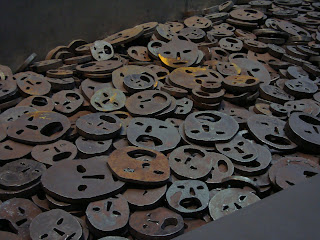Image 1: City of Istanbul
This was the first image that I took in Istanbul. In this photograph, I tried to capture the different buildings, the Golden Horn, and the vitality of the streets in order to control the shock of first seeing the city.
Image 2: Interior of the Blue Mosque
I focused on the elaborate detail of the Blue Mosque in order to show the complexities of the built environment.
Image 3: Jewish Museum Exhibit
An image of the metal faces exhibit at the Jewish museum is limited because it can in no way capture the bodily sensations that are felt by being the actual presence of it; it cannot show the immensity and noise that results from walking on the faces.
Image 4: "Don't Touch My House"
Not only does this image show a sign posted in the window of a home in Istanbul, but it requires further interpretation because its reference to the current process of gentrification and structure of power in Istanbul.
Image 5: Hagia Sophia
Before coming to Istanbul, the image of the Hagia Sophia was what I most closely identified with the city. By taking this image, I am trying to capture the memory of travelling to Istanbul.
Image 6: Gentrification in Istanbul
Image 7: Greek Orthodox Church
I chose an image of one of the flats in the Golden Horn in order to convey the idea of gentrification in Istanbul. I felt that the issue of gentrification discussed by Dr. Orhan Essen was incredibly interesting because of how it is currently transforming the present city of Istanbul. It was interesting to hear that as a result of projects such as Code 5366 that older houses were being renovated by the state in order to increase the values of the property. As a result of the increase in the value of the property, more wealthy families move into the neighborhoods while poorer families are forced out of their homes because they can no longer afford them. I think it is really important to the city of Istanbul because gentrification becomes a source of mobility in the city. Because it causes families and individuals of different socioeconomic backgrounds to migrate through the city it further emphasizes the notion that there is not a permanent location for a group of people within Istanbul and that it is a very dynamic city. Furthermore, I found it interesting that one of the justifications for the implementation of projects such as Code 5366 was that older, more established families somehow possessed an inherent right to occupy the renovated space. The argument that only a certain subset of people have the right to belong in a certain space seems to parallel the argument in the Turkish republic for a homogeneous state.
Another image that I took was an image of a church near Taksim Square in Istanbul. The presence of the church in a currently, predominantly Islamic nation demonstrates the rich cultural history present in Istanbul that Dr. Jennifer Petzen discussed during her lecture. It shows the change from being a center of the Christian Byzantium Empire to an Islamic nation state. Even though the Turkish nation state has attempted to establish a nation that is very homogenous through measures such as forcibly deporting Christians living in Anatolia to Greece, it has decided to keep these religious buildings. It was fascinating for me to see that the Turkish state would choose to keep the church and keep it in its memory and allow it to shape the identity of the city. Furthermore, I found the role of religious institutions such as churches in the provision of social networks for immigrant families to be very interesting. As discussed by Dr. Essen, for immigrants, churches provided a source of community. A source of social networking was key for the immigrant families to establish themselves. Furthermore, the idea of a church funding the surrounding area and providing social services for the community as a part of a “foundation” was a very fascinating idea for me. During the period of the Ottoman Empire, these foundations really shaped the way communities were established in Istanbul. In addition, the establishment of these foundations shaped the source of power and authority in the community. The sultan was no longer the sole source of authority; instead, communities fell under the jurisdiction of religious authorities that decided upon a different set of issues.







No comments:
Post a Comment